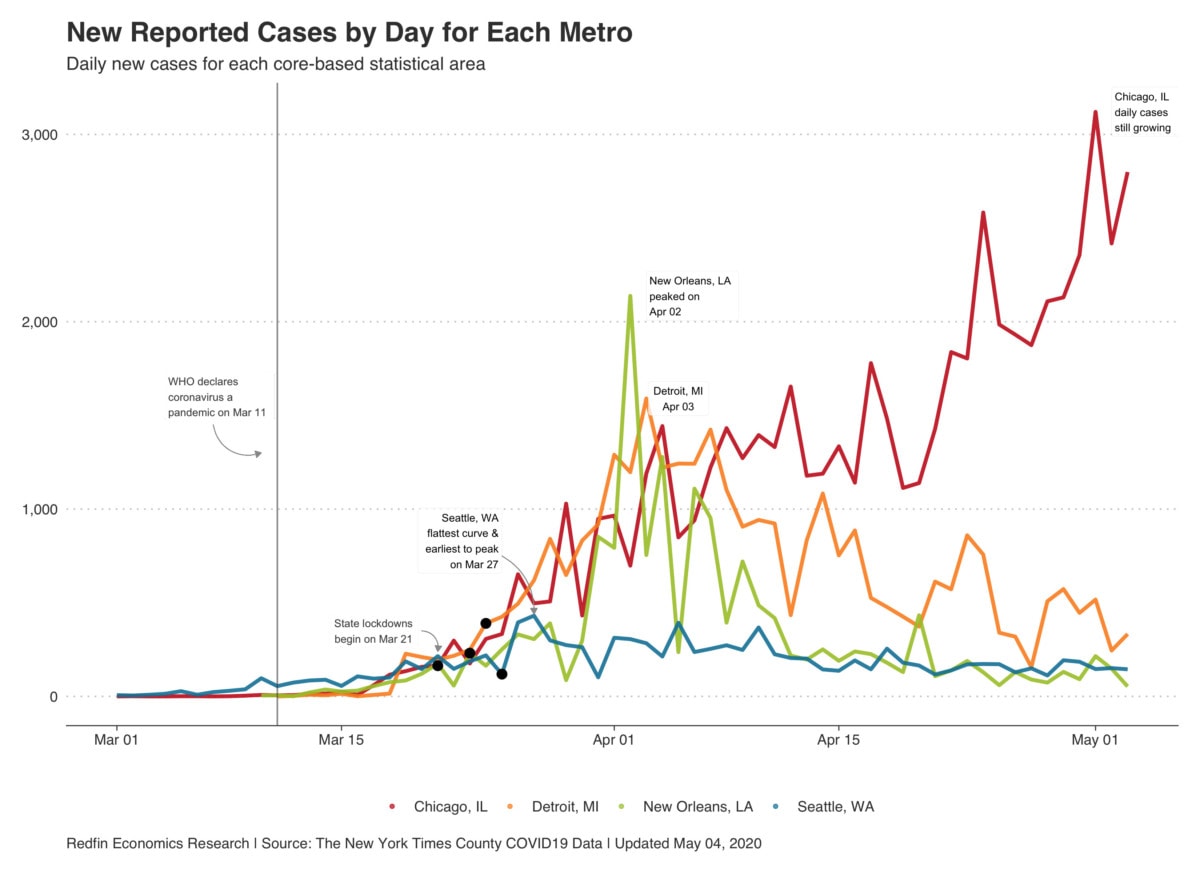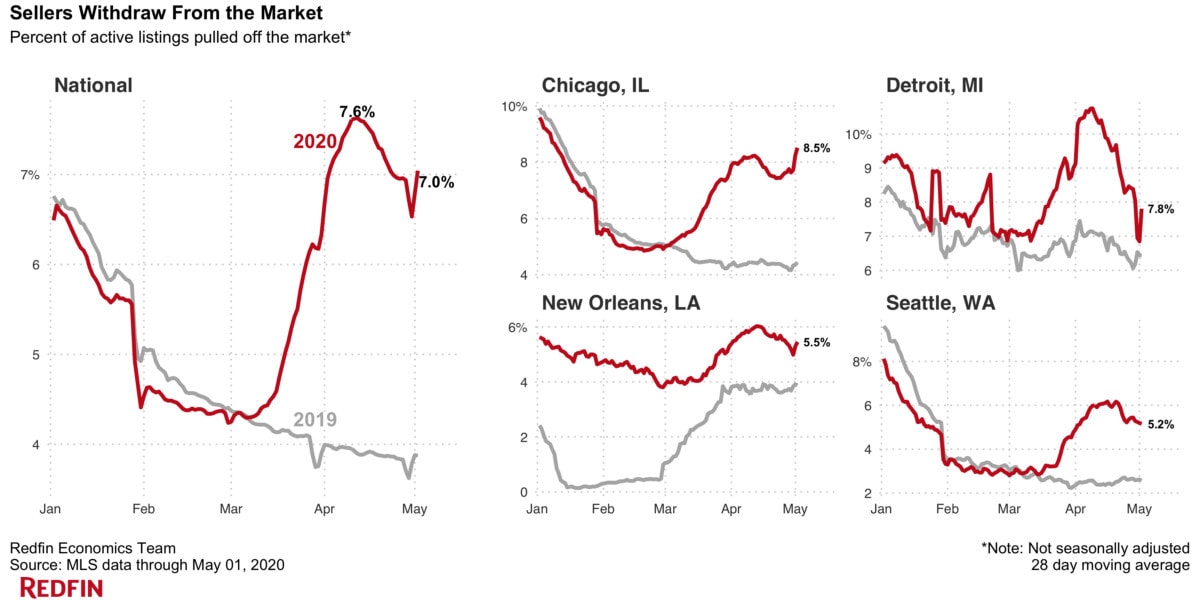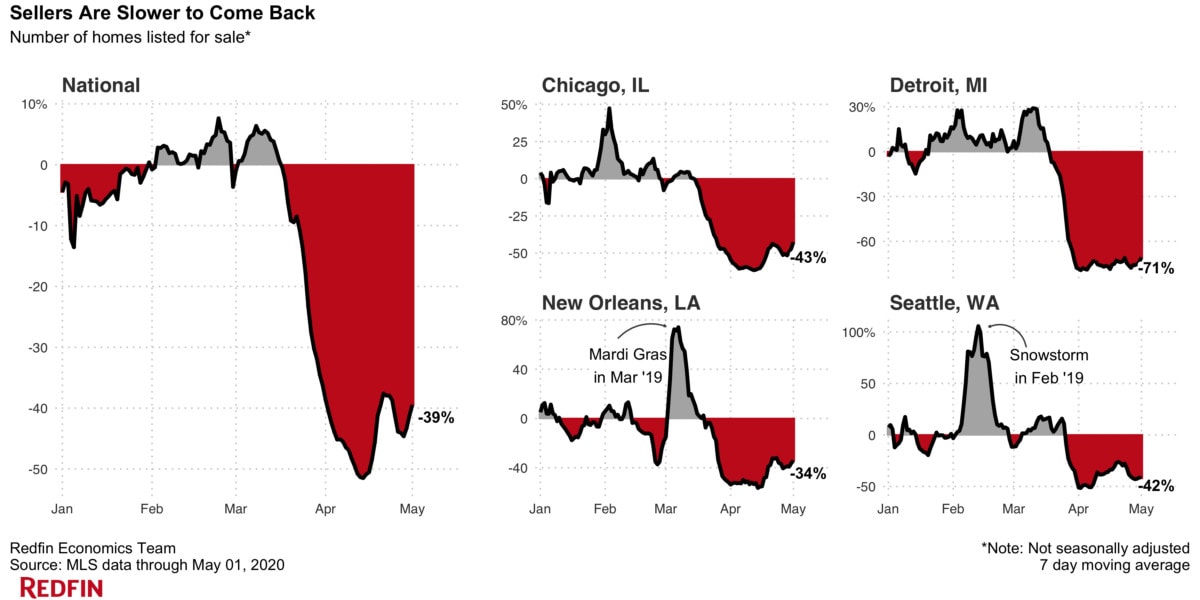Even in places where COVID-19 continues to worsen, supply and demand are showing signs of recovery. But markets that placed restrictions on real estate are lagging behind.
To better understand how the coronavirus pandemic is impacting local housing markets across the country, we identified four of the U.S. metropolitan areas that were hit hard by COVID-19 and analyzed how buyers and sellers are reacting. Specifically, we examined delistings, new listings and home sales in Chicago, where COVID-19 continues to trend upward; Seattle and New Orleans, which have flattened the curve; and Detroit, which has also flattened the curve but did not deem real estate essential.
- Chicago: The metro area hasn’t yet experienced a peak in COVID-19 cases. There were still nearly 3,000 new cases a day as of May 4.
- Detroit: The only metro in our analysis where real estate was not deemed an essential service—meaning agents are unable to show homes and visit with clients while the state’s stay-at-home order is in place—Detroit flattened the curve in early April. This week, Michigan began easing restrictions on real estate.
- New Orleans: The area experienced a relatively dramatic rise—and subsequent fall—in coronavirus cases, surpassing 2,000 daily new cases on April 2 and then quickly falling to below 500 about a week later.
- Seattle: The first reported epicenter of the U.S. coronavirus outbreak, it was also the first metro in our analysis to flatten the curve—in late March—thanks to early social distancing and testing.

“While consumers are still hurting from this pandemic, we’re starting to see early signs of recovery,” Redfin lead economist Taylor Marr said. “Supply and demand have begun to strengthen, even in places where COVID-19 is still on the rise, as homebuyers and sellers start to see a light at the end of the tunnel. This has allowed prices to remain stable.”
How Sellers Are Reacting: A Rollercoaster of Delistings
A surge in home delistings was one of the first signs that the housing market was experiencing a coronavirus-driven downturn. Nationally, delistings hit a record during the 28-day period ending April 9, when nearly 75,000 homes (1 of every 13 houses for sale) were pulled off the market. That compares with just 47,000 during the same period in 2019. Delistings have since slowed in most markets, but are still far more common than they were at this time last year.
Detroit experienced the earliest and sharpest rise and fall in delistings, likely because its housing market was forced to a standstill when the local government omitted real estate from its list of essential services, according to Marr. More than 600 homes, or about 1 in 9 houses for sale, were pulled off the market during the 28-day period ending April 5. That number had fallen to 380 homes, or about 1 in 13 listings, as of May 1.
In Chicago last month it appeared that the share of homes being delisted was starting to decline, however it has since bounced back and surpassed its prior peak. More than 2,600 homes, or 8.5% of active listings, were removed from the market during the 28-day period ending May 1. That’s up from less than 8% a month prior. With new coronavirus cases still on the rise, sellers may be realizing that a recovery could be further away than they’d initially thought, according to Marr.
Meanwhile, delistings in both New Orleans and Seattle peaked at around 6% of active listings in mid-April, and have since retreated to around 5%. While Seattle’s performance appears to mirror the gradual rise and fall in the metro’s new daily COVID-19 cases, the weekly data paint a more extreme picture. Delistings soared as much as 220% year-over-year during the seven-day period ending March 27—the same week Seattle saw its stay-at-home order go into effect and a peak in new daily COVID-19 cases. That compares with peak weekly delistings growth of 100% in New Orleans.
How Sellers Are Reacting Pt. II: Home Listings Tank—Then Trickle Back in Most Markets
NOTE: In New Orleans, the peak in year-over-year new-listings growth is inflated due to the 2019 Mardi Gras holiday. In Seattle, the peak in year-over-year new-listings growth is inflated due to the 2019 snowstorm.
Following the influx of delistings, the next sign of a supply slump was the decline in new homes being added to the market. Nationally, new listings bottomed the week ending April 14 at about 48,000 homes—around half the amount we saw during the same period last year. They’ve since started to rebound in most markets, climbing to 62,000 homes nationally during the week ending May 1.
In Seattle, new listings began to crash due to the coronavirus toward the end of March, when the stay-at-home order began and daily new COVID-19 cases hit an all-time high. They bottomed at the start of April, down 52% from the same period the prior year, and have since pared some losses, now only down around 42%. New listings in New Orleans reacted similarly, but took slightly longer to rebound, not staging a comeback until mid-April.
Detroit saw the biggest collapse in new listings, sinking as much as 79% from the prior year during the week ending April 2. Unlike the other metros in our analysis, new listings in Detroit have yet to rebound significantly, still down 70%, as real estate wasn’t deemed an essential service. Realtors in Detroit can’t even lead in-home video tours, said local agent Tony Orlando. If a prospective buyer wants to see a home, the seller has to be willing to conduct the virtual tour.
“Listings are pretty much frozen,” Orlando said. “We had a really rough beginning—people just had no interest in seeing homes, even virtually. The good news is that we’re starting to see an uptick in tour requests as we get further into the spring season and the initial panic surrounding the coronavirus subsides.”
Interestingly, new listings in Chicago are now only down 43% following a plunge of as much as 61% in April , despite continued growth in new daily COVID-19 cases. This may indicate that sellers are seeing glimmers of hope as other cities flatten the curve, Marr said.
How Buyers Are Reacting: Sales Sink, Then Rebound

As supply collapsed in April, so did demand—although it has seen a relatively quick comeback in some markets. The number of homes under contract to be sold plummeted nationally by 43% to about 32,000 during the week ending April 16, as buyers backed away from the market amid skyrocketing unemployment. Sales have since started to recover. While it appears that they declined again at the beginning of May, that is partially due to timing of the Easter holiday.
New Orleans has experienced the sharpest rebound, mirroring its encounter with COVID-19. With new coronavirus cases lower than any of the other three metros, pending sales in New Orleans are now up 2% year-over-year. That follows a record 54% plunge during the first week of April—the same week the metro saw COVID-19 cases peak.
The Seattle metro has also seen a stark comeback, with pending sales now down just 21% following a 55% decline in early April.
“It feels like buyers are keyed up and ready to start looking again. We’ve seen a lot of interest in the last 10 days, compared with crickets just three weeks ago,” said Amber Allin, a Redfin agent in Tacoma, WA, which is part of the Seattle metro area. “The first-time homebuyer market is still really hot, and properties that are in good condition are moving incredibly well.”
Despite the continued rise in COVID-19 cases, demand in Chicago has also shown resilience—albeit not as much as in Seattle or New Orleans. Pending sales are now down just 37%, an improvement from the 58% decline in April.
“Chicago’s housing market has felt somewhat insulated from this pandemic,” said local agent Daniel Close. “It’s not universal, but buyers still seem excited to make offers, motivated to fight for homes, and willing to engage in bidding wars. That hasn’t really changed; there are just fewer people in the market.”
Of the four metros in our analysis, Detroit has seen the weakest rebound, with homes under contract now down 70% after bottoming at about 80%. Still, people are buying move-in ready houses at lower price points, according to local agent Orlando.
“Homes going for $250,000 and under are still super competitive,” Orlando said. “One of my clients toured a $215,000 house in Pontiac, MI on a group Zoom call with several other prospective buyers the day it hit the market. Within 30 minutes, there were four offers. The property went for above-asking during a pandemic.”

 United States
United States Canada
Canada